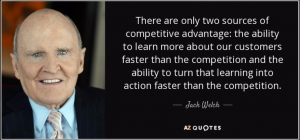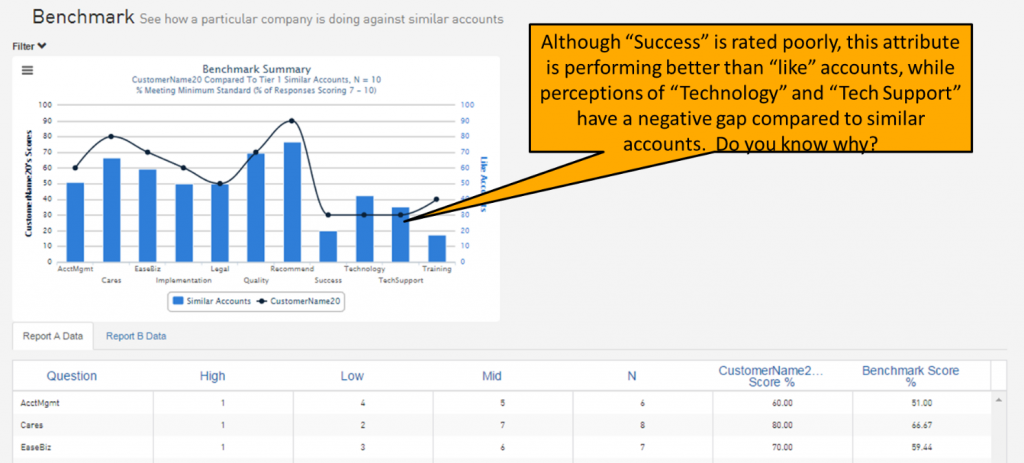Search Waypoint Resources
The Secret to Easy B2B Retention & Expansion = Relationships. Here’s how.

Loyalty nowadays seems to be the stuff of coffee shop stamp-cards in wallets, dogeared and half stamped. Loyalty is crucial for B2B businesses as well, but far more challenging to measure since
- There are many contacts in the account, many of which may be executives that don’t often (ever?) use your products,
- The “users” of your products often have little say in the buying decisions.
But one thing is universal: the people in the account (a.k.a. the “customer”) that feel like you care and deliver against their differing wants and needs – i.e. those that feel a connection with your company because you show you care – are more likely to be loyal than those that lack any sense of relationship. By the way, please don’t confuse loyalty with retention: an individual may be stuck with your product because the hard- or soft-costs to switch are too high. But a loyal customer will bring new business that will accelerate financial growth, either directly (through expansion) or indirectly (through word-of-mouth).
So how do we build the strong relationships with our customers that bring loyalty? More to the point, how do we do that within the busy day to day of running a business? When Customer Success Managers (CSMs, or Account Managers/Owners) are dealing with many accounts of varying sizes, how can they possibly make each feel heard and special to strengthen the relationships that drive loyalty?
 First, what if the way you’re approaching your accounts is weakening your customer relationships rather than strengthening them? Recognize that the practices we are using with our accounts aren’t necessarily those we should be. Look at the essence of any contact with the customer: Is the interaction intended to add value for the customer, or for you? To strengthen a customer relationship you must do more things that your customer will find valuable, and fewer things that aren’t. Perhaps you recognize some of these customer relationship mistakes:
First, what if the way you’re approaching your accounts is weakening your customer relationships rather than strengthening them? Recognize that the practices we are using with our accounts aren’t necessarily those we should be. Look at the essence of any contact with the customer: Is the interaction intended to add value for the customer, or for you? To strengthen a customer relationship you must do more things that your customer will find valuable, and fewer things that aren’t. Perhaps you recognize some of these customer relationship mistakes:
- “Dear customer, your account will be expiring and we need to work on the renewal.” This is not customer relationship building. If you were looking for a way to make your customer unhappy, only contacting them when it’s about money will do that. Renewals are necessary but make sure your customer perceives value from you first, otherwise the renewal will certainly be in jeopardy anyway, and you’ll find out far too late to do anything about it.
- “Dear customer, I just wanted to check in and see how things are going.” How does “checking in” help the customer? Having a purpose for checking in will be a better way to strengthen customer relationships. Perhaps you wish to ensure they are realizing value and you are willing to work actively to ensure they realize it. Or maybe you saw a drop in their product utilization or need to understand if employee change-over means that new training or consulting should be delivered. “Checking in” might help you be able to tell your management that you are regularly in touch with your customers, but it doesn’t move the needle. Reaching out is always good, but if you’re not adding value then you shouldn’t be doing it.
- “Dear customer, will you act as a reference for us?” Before reaching out, make sure you are entitled to even ask based on the customers’ realization of value. Then, make sure you understand the “what’s in it for me” for this contact – does the reference call help them develop new relationships, extend their reach, or expose them to new opportunities? Make sure to position those benefits to the customer contact, and otherwise recognize that you are eroding the customer relationship, spending “points” if you will, that will be exhausted if not developed.
- “Dear customer, will you be attending our event?” This shows less of an interest in your customer and more of an interest in your event numbers. If you really want to ensure your customer will be at an event, why not arrange to meet up with them there to introduce them to specific people that you know they would want to meet?
- “Dear customer, will you respond to our survey?” We are all inundated daily by survey requests, from the survey email telling customers how quick the survey will be, to the request which comes with entry into a prize draw. Responding to a survey that creates a score for your company is a favor to your organization and should be framed as such. So, forget prize draws: you just need to show your customer their response will be acted upon and their feedback is important to you. Try framing your request as, “We always act on the feedback we are given [and evidence/examples would be important here!]… will you provide me with feedback so I/we can improve?” If you’re inundating your customer with surveys to help you craft your business response, then you better be reaching out personally afterward to talk about how you will be addressing their response. It’s a two-way street, ‘QUID PRO QUO CLARICE,’ as it were. If you ask time from your customer to help you, then you must show them how that time will also help them as they are paying you to do so.
With these negative examples behind us, let’s move to discuss how to strengthen customer relationships. Our experience shows that relationships are strengthened through an ongoing process of:
- Listening: How well do you understand the expectations — the wants and needs – of your customer? We constantly hear CSMs/Account Execs say, It’s my job to understand how the customer feels and I am in touch with them all the time to know that.” But consider:
- Who is the CSM talking to, and is that person truly representing the diverse wants and needs of all the various people (with differing roles) in the organization?
- Are they asking straight questions with clear answers, or might they be making assumptions? Just because someone complains often doesn’t mean they are unhappy, nor does a lack of complaints mean that someone is truly loyal.
Chances are the CSM is engaged with a day-to-day “champion” (key contact, coach, etc) who probably doesn’t set business objectives (seek business outcomes), own the required resources, or approve the purchase. This doesn’t mean that their champion/coach is the wrong person, just that there likely is a blind spot.
When you’re reaching out to your customer, it’s easy to assume your customer is your end-user, but that’s probably not the case. Your customer is likely to be someone with the budget, and their overall sentiment will be shaped by business outcomes (results) at least as much as the end-users’ product experience.
“If the food isn’t great then you’ll never come back. But it takes more than great food to get people coming back.”
– Danny Meyer, Founder of Shake Shack (the US-based burger joint with a fanatical following!)
- Aligning: Once you’ve listened, you are in a position to address the customer’s expectations: You’ll either need to deliver against them, or you’ll need to manage (change) their expectations. To strengthen relationships, you must choose to do either or both. And recognize that expectations span far more than product feature/function, as Danny Meyer says about Shake Shack in the quote above. If only the “product” mattered to create new happy customers, then why does the rest of the company exist? What goes along with the product — best practices, policies, pricing, education, service and support — can be at least as important as feature/function.
In other words, your company must (at least) meet your customer’s expectations. If there’s a gap, either ratchet down expectations, or step up your delivery.
Jack Welch, the former Chief Executive of General Electric (GE) said it best:

Don’t assume that Jack was referring to “customers” in the aggregate: understanding and aligning the wants and needs of individuals with differing expectations is the key, even if it’s one customer at a time.
How well do you know your customers’ expectations? Expectations are set by your own sales and marketing, but also from competitors (you don’t think they’re only speaking with you, do you?) and other companies that the customer might have experienced. I admit I’m a huge fan of Amazon.Com because it’s so easy. I naturally expect other companies to work similarly; not just technically, but through policies that have the customer in mind, such as their no-nonsense way of making returns so easy without making me feel like a criminal.
So without getting out our customer crystal ball, how can we meet these expectations, especially when they have so many factors?
It’s easy: Ask them.
It may sound like an obvious solution, but that’s because it works. How better to know what your customer feels is lacking, or was promised, than to ask? There is a reluctance to ask customers for feedback, perhaps because we don’t want to have to report negativity, or because we feel the messenger might be blamed. The truth remains that asking is the easiest, most cost effective, and timely way of finding out what your customer is thinking and where you may be falling short. It is only when you get feedback from a cross section of the right people in the account you’ll get a true picture.

Would you rather know, or just pretend that there are zero gaps in customer expectations?
Now the question should be, how do you do this at scale? We’ve written before about a practice we call active recruiting, which probably takes a total of ~15 minutes per account. It’s 3 simple steps:
- Position the feedback effort with your champion and ask if they will participate. The questions you ask can be very simple about the experiences and ability to meet expectations, but remember to always include at once one question that also helps you uncover their overall sentiment, because you might erroneously assume that missed expectations == detractors. Know the sentiment overall and view their feedback in that context. Now you have at least one data point.
- Ask your champion who else in the account is in a position to provide feedback around what’s working and not working about the overall relationship between the two companies. Now you’ve got your list.
- Craft a short email that positions the importance of feedback, and ask your champion to forward that email to the list established in #2. They are certainly more likely to open and act on that email than yours. Now you’ve got feedback.
All of this can more fully automated by using “survey” tools such as TopBox. But I’d advise to prioritize process and outcomes before technology, as described in great detail in the book, Failure Sucks! More For Your Customers Than You.
Now that you’ve got feedback, the next step is to take advantage of it. There are 3 ways to think about this:
- Urgent follow-up on “detractors.” Someone who is vocalizing that they are unhappy is begging for help. Demonstrate that you care by calling and addressing their issues.
- At least for strategic accounts, Joint Success Planning is a great way of gleaning a feedback-based action plan to strengthen customer relationships and drive expansion opportunities. By using the Joint Success Plan template you can work with your customer to prepare a strategy to move forward together, focusing on key areas of improvement and those that are working well. This allows both parties to work together and craft a goal driven document agreed on by both sides, a growth contract, of sorts.

Screenshot from TopBox – the Customer Engagement platform – that highlights optimal improvement opportunities by comparing one account to its peers.
- It is understood that not all accounts can garner the same high-level focus: smaller accounts can’t be high touch. But you can still analyze the feedback of small accounts in aggregate and communicate what is working well and what needs improvement. You can also work on putting together an improvement plan which you will commit to so you can meet their needs, and close the loop, by making commitments, keeping them and telling them what you did.
The secret to good customer relationships and gain the resulting loyalty is good listening and communication. Somewhere along the way many businesses have forgotten that they need to collaborate with their customers and although it isn’t revolutionary, it is imperative. When your customers feel listened to, and like they’re getting value from their relationship with you, they are happier in maintaining your ongoing services. Having a vendor that meets agreed upon commitments inspires trust and loyalty, and customers who trust you will be loyal. Loyal customers will accelerate new business. It’s good to show your customers that you listen!